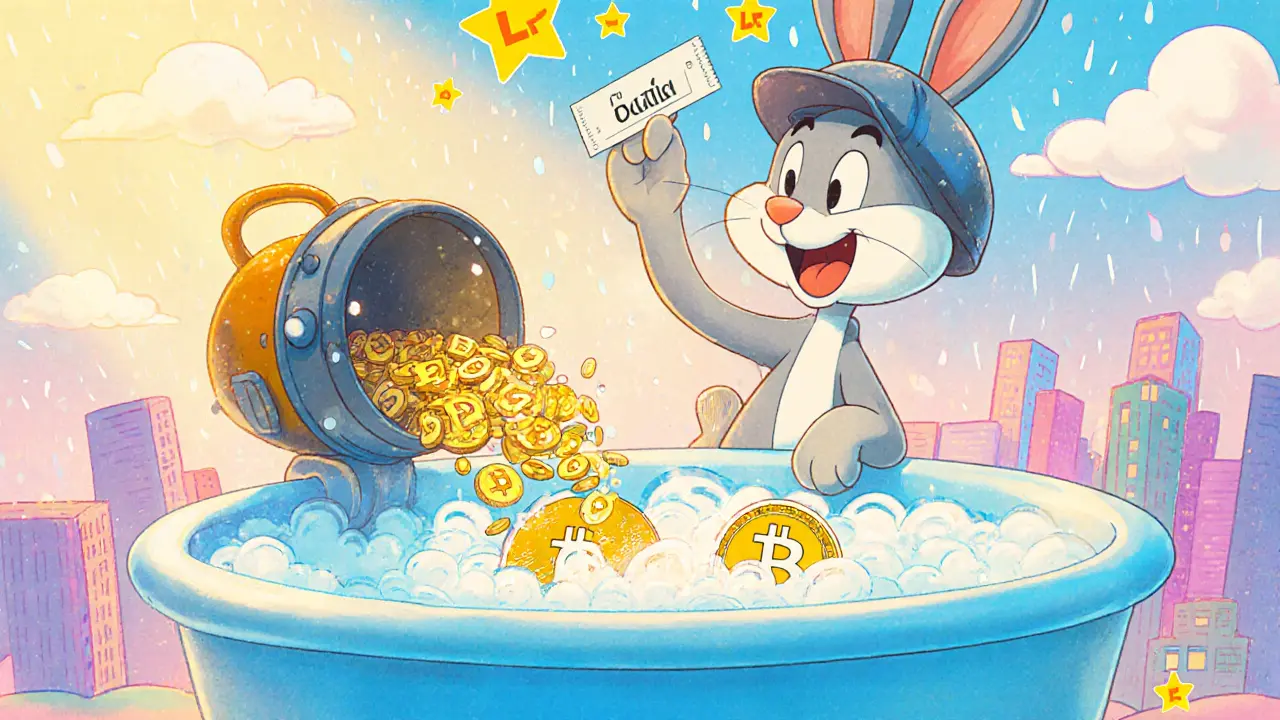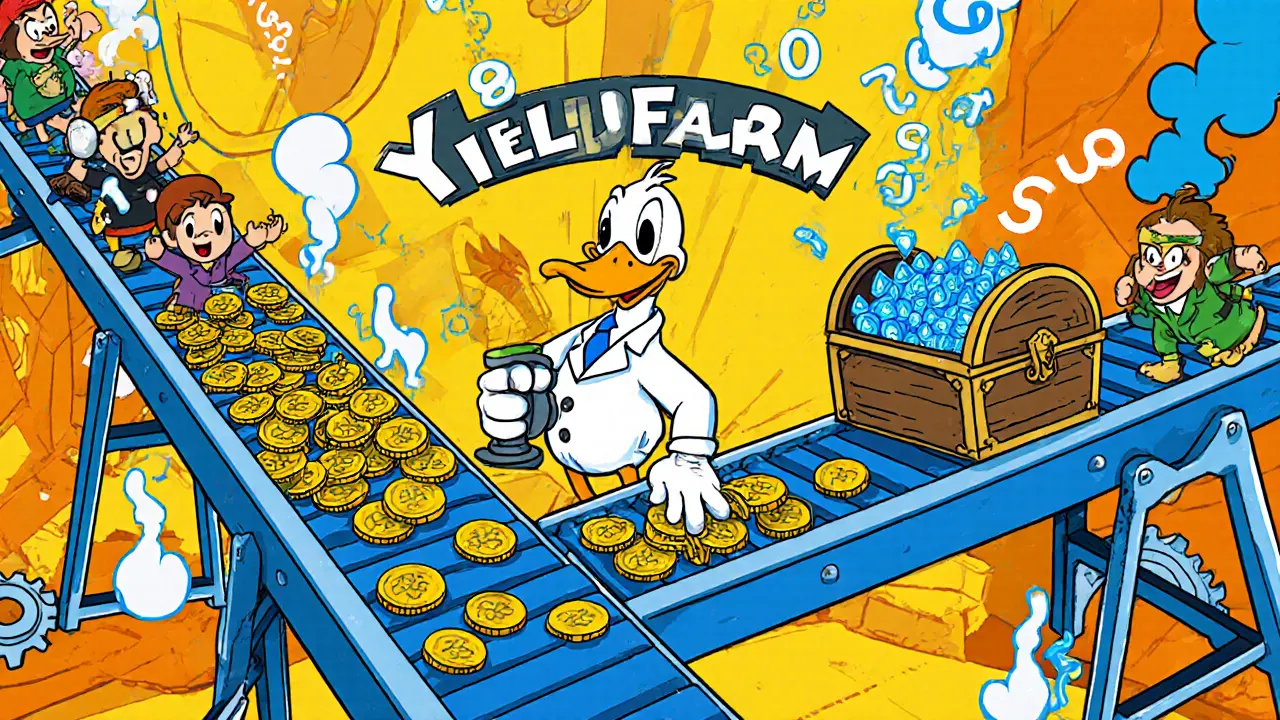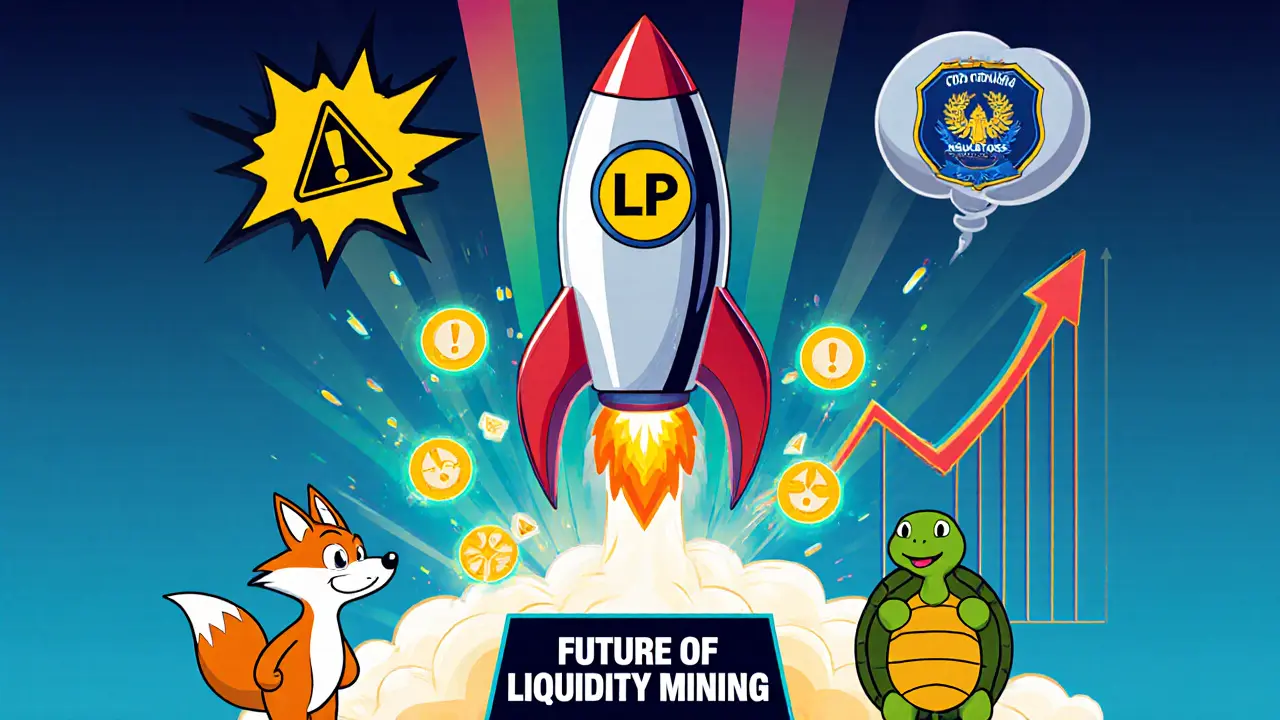Understanding Liquidity Mining Rewards in DeFi
 Sep, 17 2025
Sep, 17 2025
Liquidity Mining Rewards Calculator
Estimated Monthly Rewards
- This calculator provides estimates only. Actual rewards depend on pool performance and market conditions.
- Consider impermanent loss when evaluating potential returns.
- Token emissions may vary based on protocol decisions and market dynamics.
When you hear about Liquidity mining rewards is a dual‑incentive system that pays users for supplying capital to decentralized exchange pools and for staking the pool receipts in yield farms. In simple terms, you lock up crypto, earn a slice of the trading fees, and collect extra tokens that the protocol issues. The promise is easy: turn idle assets into a steady stream of income without the hardware, electricity, or solo‑mining headaches of traditional mining.
What Exactly Is Liquidity Mining?
Decentralized finance (DeFi) is the broader ecosystem where traditional financial services-lending, trading, insurance-run on smart contracts instead of banks. Within DeFi, a liquidity pool is a smart contract that holds two (or more) assets, allowing anyone to swap between them. When you deposit assets, the protocol gives you LP tokens, a digital receipt that represents your share of the pool.
Liquidity mining adds a second layer. Instead of just holding LP tokens, you stake them in a yield farm. The farm locks your receipt and, in return, distributes the protocol’s native protocol token. These tokens often grant governance rights and can be sold for profit.
How the Two‑Part Reward System Works
1. Fee earnings: Every trade that touches your pool generates a small fee (usually 0.05%-0.30%). That fee is automatically split among all LP token holders, proportional to their share. 2. Token emissions: By staking your LP tokens in a farm, you become eligible for a stream of protocol tokens. The distribution is usually continuous-updated every block or every few minutes-so you see your balance grow in real time.
The math is straightforward. Suppose a pool holds $1million in total value and you contribute $10,000 (1%). If the pool generates $5,000 in fees over a month, you earn $50. On top of that, the farm might be set to emit 100,000 XYZ tokens per month, divided among all stakers. If the total staked amount equals $10million, your $10,000 stake captures 0.1% of the emissions, giving you 100 XYZ tokens. The actual dollar value of those tokens depends on market price.
Design Dimensions: Who, How Much, and When
Researchers at Multicoin Capital break liquidity mining into three design questions:
- Who gets paid? Makers (liquidity providers), takers (traders), and service providers (keepers, liquidators) can all receive rewards.
- How much do they get paid? Compensation can be based on the dollar amount of liquidity, the duration of provision, or the actual fees routed through the protocol.
- When do they get paid? Most programs use fixed schedules (e.g., daily token drops), but newer models adjust payouts based on real‑time fee revenue.
Understanding these dimensions helps you evaluate whether a farm is truly rewarding your contribution or merely inflating token supply for marketing hype.

Key Benefits That Drive Adoption
Liquidity mining solves two big problems at once. First, it bootstraps liquidity for new projects-deep pools make prices stable and attract traders. Second, it distributes governance tokens to active users, resulting in more decentralized decision‑making. Advanced variations such as concentrated liquidity (Uniswap V3) let providers allocate capital to narrow price ranges, potentially increasing fee capture. Vote‑escrowed tokenomics (like Curve’s veCRV) lock tokens for voting power and boost rewards, aligning long‑term incentives.
Risks You Can’t Ignore
Every shiny yield comes with hidden costs.
- Impermanent loss: If the price ratio between the two assets in a pool diverges, the value of your LP share may fall below simply holding the assets. The loss is “impermanent” only if prices revert; otherwise, it becomes permanent when you withdraw.
- Mercenary capital: High‑yield farms attract opportunistic providers who jump in, reap rewards, and exit once the APY drops, leaving the protocol with thin liquidity.
- Token price pressure: Continuous token emissions create selling pressure whenever participants claim and liquidate their rewards.
- Smart‑contract risk: Bugs or exploits can drain funds. Audited contracts reduce risk, but no code is 100% safe.
- Gas fees: On congested networks like Ethereum, claiming rewards can cost $30-$50, eating into small returns.
Step‑by‑Step: Getting Started with a Real‑World Example
Let’s walk through a typical Uniswap V3 liquidity mining session on the Polygon Layer2 (low fees).
- Set up a non‑custodial wallet (MetaMask is the most common). Connect it to the Polygon network.
- Choose a pool-say USDC/USDT within a $1‑$1.05 price range. Deposit equal values of both tokens.
- After the deposit, you receive LP tokens that represent your share of that narrow range.
- Navigate to the Uniswap “farm” page, click “Stake LP”. Approve the contract to move your LP tokens, then confirm the stake.
- Watch the dashboard. Fees earned appear as a growing USDC amount, while the farm shows accrued UNI tokens.
- When you decide to exit, first “unstake” the LP tokens, then “remove liquidity” to get back USDC and USDT. Claim any pending UNI rewards, and consider swapping them for a stablecoin to lock in profits.
Typical APYs on Polygon for stable‑stable pools range from 5% to 12% (fees) plus an extra 8%-20% in UNI emissions, depending on market conditions.

Comparison of Reward Components
| Aspect | Trading Fees | Protocol Tokens |
|---|---|---|
| Source | Every swap that touches the pool | Emission schedule set by the protocol |
| Predictability | Depends on volume; can be volatile | Often fixed per block, but can be dynamic |
| Tax treatment (US) | Ordinary income | Capital gains when sold |
| Impact on APY | Generally lower (5%‑15% for stable pools) | Can boost APY to 30%‑100% for new farms |
| Risk factor | Impermanent loss risk only | Token price risk + possible sell pressure |
Tips to Maximize Returns and Minimize Pain
- Start small on a reputable chain. Low‑fee networks like Polygon, Arbitrum, or Optimism let you test the mechanics without eating most of your earnings on gas.
- Calculate impermanent loss. Use online calculators (many DeFi dashboards embed them) to see if the projected fee earnings outweigh the loss.
- Lock tokens for boosted rewards. Platforms like Curve let you lock CRV for veCRV, which can multiply your token rewards by up to 2‑3×.
- Re‑balance periodically. If one side of a pair rises sharply, consider adjusting your price range (in concentrated liquidity) or pulling out to avoid deep loss.
- Watch for reward decay. Many farms halve emissions after a set period. Plan an exit or move to a newer farm before the payout drops.
Future Outlook
Liquidity mining has matured. Total value locked across mining‑enabled protocols sits near $50billion in 2025, down from the 2021 peak but still sizable. Cross‑chain bridges are letting providers earn on multiple ecosystems from a single wallet. Layer‑2 scaling keeps fees low, making tiny positions viable. Expect more “dynamic” reward models that tie token emissions directly to fee revenue, reducing the mercenary‑capital problem. Regulators are watching token reward schemes for securities violations, so projects may add more compliance layers-potentially affecting reward sizes.
Frequently Asked Questions
What is the difference between liquidity mining and yield farming?
Liquidity mining describes the specific act of providing assets to a pool and earning fees plus protocol tokens. Yield farming is a broader term that includes any strategy-staking, lending, or borrowing-to generate returns, and it often incorporates liquidity mining as one component.
How can I estimate my impermanent loss before joining a pool?
Use a calculator that asks for the initial price ratio, the expected future price ratio, and your deposit amounts. Most dashboards (Uniswap, SushiSwap) embed a link to such tools. Plug in realistic price scenarios and compare the projected fee earnings against the loss figure.
Are liquidity mining rewards taxable?
In the United States, fee earnings are treated as ordinary income at the time you receive them. Protocol tokens are taxed as capital assets when you sell or exchange them, so you may owe capital‑gains tax on any appreciation.
What happens to my LP tokens if a protocol gets hacked?
If the smart contract is compromised, funds-including your LP tokens-can be drained. That’s why you should only use audited contracts, check community reputation, and consider diversifying across several reputable platforms.
Can I earn rewards on a single‑token pool?
Some platforms offer “single‑sided” farms where you stake just one token (e.g., ETH) and earn rewards. These usually carry lower risk of impermanent loss but may offer lower overall APY compared to dual‑token pools.
Jade Hibbert
September 17, 2025 AT 03:37Oh great, another calculator that tells you nothing.
Leynda Jeane Erwin
September 22, 2025 AT 06:17While the interface is commendably concise, one must consider the underlying assumptions inherent in such estimations.
Brandon Salemi
September 27, 2025 AT 08:57Liquidity mining? It's the hype beast of DeFi, and we're all just riding its back!
Siddharth Murugesan
October 2, 2025 AT 11:37If you actually believe that hype will pay your rent, you’re living in a fantasy.
Nina Hall
October 7, 2025 AT 14:17Imagine a garden where every flower is a token, and you get to water them with fees-pure poetry!
Lady Celeste
October 12, 2025 AT 16:57Poetry? More like a prank.
Ethan Chambers
October 17, 2025 AT 19:37Most analyses miss the subtle macroeconomic currents that render these simplistic calculators obsolete.
gayle Smith
October 22, 2025 AT 22:17Indeed, the APR volatility matrix supersedes any static fee rate projection, rendering the UI elementary at best.
Rama Julianto
October 28, 2025 AT 00:57Stop whining and plug the numbers; the real issue is your failure to account for token vesting cliffs.
Helen Fitzgerald
November 2, 2025 AT 03:37Hey, don't be hard on yourself-just double‑check the vesting schedule and you'll see clearer numbers.
Jon Asher
November 7, 2025 AT 06:17Good point, always look at the lock‑up periods before you jump in.
Scott Hall
November 12, 2025 AT 08:57Yep, chill vibes and math checks keep the panic at bay.
Hanna Regehr
November 17, 2025 AT 11:37Remember that the emissions curve often tiers down after the early incentivized phase, so adjust expectations accordingly.
Ben Parker
November 22, 2025 AT 14:17👍🏽 Got it! Thanks for the heads up! 😊
Daron Stenvold
November 27, 2025 AT 16:57In the grand tapestry of decentralized finance, the allure of liquidity mining appears at first glance as a beacon of passive profit.
Yet, upon closer scrutiny, one must confront the intricate lattice of variables that govern reward distribution.
The nominal fee‑share percentage, while seemingly generous, is subject to the vicissitudes of trading volume, which itself fluctuates with market sentiment.
Moreover, token emissions are rarely static; governance decisions can truncate or accelerate the schedule without warning.
Impermanent loss, a specter lurking behind every pool, erodes capital in a manner that many novices overlook.
Thus, the calculator’s output, though neatly formatted, remains a mere approximation.
An astute participant will layer this datum with on‑chain analytics, examining historic APR trends and token price volatility.
Furthermore, the composability of the protocol-its interactions with other yield farms-introduces cross‑protocol risk that compounds the calculation.
One must also factor in gas costs, particularly on congested networks, as they can consume a non‑trivial slice of the purported earnings.
Regulatory uncertainty adds another dimension; future legislative actions could impinge upon token utility and, by extension, reward value.
Consequently, a prudent strategy entails diversifying across pools with differing risk‑reward profiles.
Regularly rebalancing positions in response to evolving market metrics ensures that exposure aligns with one’s risk tolerance.
Finally, maintain a disciplined record‑keeping regimen to track realised versus projected yields, enabling iterative refinement of one’s model.
Only through such rigorous, multidimensional analysis can the promise of liquidity mining translate into sustainable returns.